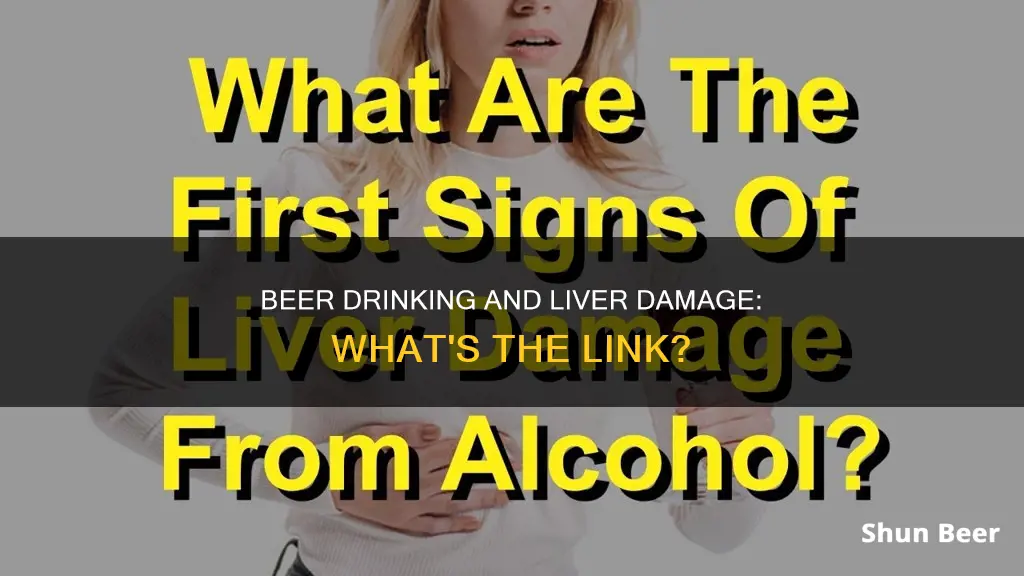
Alcohol-related liver disease (ARLD) is a common condition that refers to liver damage caused by excess alcohol intake. The liver is one of the most complex organs in the body, responsible for filtering toxins from the blood, producing bile to aid digestion, and regulating blood sugar and cholesterol levels. While the liver is resilient and capable of regenerating itself, frequent alcohol abuse can lead to long-term liver damage. This occurs when alcohol is left unprocessed by the liver and circulates through the bloodstream, affecting vital organs such as the heart and brain. Heavy drinkers are at an increased risk of developing ARLD, which progresses through several stages of severity, including fatty liver disease, alcoholic hepatitis, and cirrhosis. The best way to prevent and treat ARLD is to abstain from alcohol or stick to moderate drinking levels.
| Characteristics | Values |
|---|---|
| Liver damage caused by | Excess alcohol intake |
| Types of liver disease | Alcoholic fatty liver disease, Alcoholic hepatitis, Alcohol-related cirrhosis |
| Alcoholic fatty liver disease | Build-up of fats in the liver |
| Alcoholic hepatitis | Inflammation of the liver |
| Alcohol-related cirrhosis | Replacement of normal liver tissue by scar tissue |
| Alcoholic liver disease symptoms | Poor appetite, weight loss, spider-like blood vessels on the skin, fluid buildup in the legs and abdomen, yellow colour in skin and eyes, redness on the palms, easy bruising and abnormal bleeding, confusion or problems thinking, pale or clay-coloured stools, bleeding in the gastrointestinal tract |
| Alcohol-related liver disease symptoms | Yellowing of the eyes or skin, swelling in the ankles and tummy, confusion or drowsiness, vomiting blood or passing blood in stools |
| Treatment | Abstinence from alcohol, healthy diet, vaccination, medication |
| Prevention | Abstinence from alcohol, sticking to recommended limits, spreading drinking over several days, having drink-free days |
| Safe drinking limits | Men: 2 drinks per day; Women: 1 drink per day |
| Binge drinking | Men: 5 or more drinks within 2 hours; Women: 4 or more drinks within 2 hours |
| Extreme binge drinking | Drinking at levels far beyond the binge threshold |
| Risks | Liver cancer, kidney failure, hypertension, bleeding disorders, mental confusion, coma |
What You'll Learn

Alcoholic fatty liver disease
The liver is the body's largest internal organ and performs several vital functions, including:
- Filtering toxins from the blood
- Aiding digestion of food
- Regulating blood sugar and cholesterol levels
- Helping fight infection and disease
- Storing energy
- Making bile to aid digestion
- Producing proteins that work in many places in the body, such as blood-clotting proteins
Each time the liver filters alcohol, some of its cells die. While the liver can develop new cells, prolonged alcohol misuse over many years can reduce its ability to regenerate. This can result in serious and permanent liver damage.
The risk of alcoholic fatty liver disease is higher for heavy drinkers who are female, obese, or have certain genetic mutations. Alcoholic fatty liver disease can lead to cirrhosis, which is generally irreversible. However, stopping drinking alcohol immediately can prevent further damage and significantly increase life expectancy.
The treatment for alcoholic fatty liver disease is to stop drinking alcohol, preferably for the rest of one's life. This gives the liver the best chance to recover. If an individual is dependent on alcohol, stopping drinking can be challenging, but support, advice, and medical treatment may be available through local alcohol support services.
Beer and Abs: Is It Possible to Have Both?
You may want to see also

Alcoholic hepatitis
The liver's job is to break down alcohol. If a person drinks more alcohol than their liver can process, it can become badly damaged. Alcoholic hepatitis usually progresses to cirrhosis if the person continues to drink. For those who stop drinking, hepatitis usually returns to normal within a few months, but any cirrhosis that has occurred will not reverse.
The symptoms of alcoholic hepatitis include:
- Jaundice
- Fever
- Nausea and vomiting
- Abdominal pain
- Fatigue
- Weakness and muscle wasting
- Increased pressure in the liver
- Accumulation of fluids in the abdomen and legs
- Confusion, decreased concentration and changes in behaviour
- Poor appetite and weight loss
- Red spider-like blood vessels on the skin
- Yellow colour in the skin, mucous membranes, or eyes (jaundice)
- Redness on the palms of the hands
- Easy bruising and abnormal bleeding
- Pale or clay-coloured stools
- Bleeding in the gastrointestinal tract
The treatment for alcoholic hepatitis is abstinence from alcohol, along with adequate nutritional support. About 10-20% of patients with alcoholic hepatitis are likely to progress to cirrhosis annually, and 10% of individuals with alcoholic hepatitis have a regression of liver injury with abstinence.
In severe cases of alcoholic hepatitis, a liver transplant may be required. However, there are several barriers to liver transplants for patients with alcoholic hepatitis, including fear of recidivism, organ shortages, and social and ethical considerations.
Ice-Cold Beer: Enhancing or Ruining Your Drinking Experience?
You may want to see also

Cirrhosis
Causes of Cirrhosis
- Chronic viral infections like hepatitis B and hepatitis C
- Metabolic factors such as high blood lipids, blood sugar, and blood pressure
- Autoimmune diseases, including autoimmune hepatitis, primary biliary cholangitis, and primary sclerosing cholangitis
- Genetic disorders, such as glycogen storage disease, cystic fibrosis, and Wilson disease
- Long-term exposure to environmental toxins or certain medications, including over-the-counter painkillers
- Cardiovascular conditions like congestive heart failure or chronic ischemia, which affect blood flow to the liver
Symptoms of Cirrhosis
The early signs of cirrhosis may include nausea, loss of appetite, fatigue, weakness, upper abdominal pain, and visible blood vessels that resemble spiders (spider angiomas) on the skin. As the condition advances, symptoms become more noticeable and fall into two main categories: those related to declining liver function and those related to portal hypertension, a condition caused by scar tissue compressing the portal vein.
Symptoms related to declining liver function include:
- Jaundice, a yellow tint to the skin and eyes
- Pruritus, or severe itchy skin without a visible rash
- Dark-coloured urine and light-coloured stools
- Difficulty digesting fats
- Small yellow bumps of fat deposits on the skin or eyelids
- Unexplained weight loss and muscle loss
- Hepatic encephalopathy, characterised by confusion, disorientation, and mood changes
- Motor dysfunction, including twitching, tremors, or lapses in muscle control
- Disruptions to the menstrual cycle
- Enlarged male breast tissue and shrunken testes
Symptoms related to portal hypertension include:
- Swelling in the abdomen (ascites) and hands, feet, legs, or face (edema) due to fluid accumulation
- Easy bleeding and bruising (coagulopathy)
- Blood in vomit or stools
- Low urine output, indicating chronic kidney failure
- Shortness of breath resulting from chronic respiratory failure
Treatment and Prevention of Cirrhosis
While there is no specific cure for cirrhosis, treating the underlying causes can help slow or stop its progression. For alcohol-related cirrhosis, abstaining from alcohol is crucial. In cases of non-alcoholic cirrhosis, managing metabolic factors like cholesterol and blood sugar can provide relief. In severe cases, a liver transplant may be required, especially if the patient develops liver cancer.
To prevent cirrhosis, it is essential to minimise risk factors such as heavy alcohol consumption and address any underlying chronic liver conditions. Maintaining a healthy diet and lifestyle can also reduce stress on the liver and slow the progression of the disease.
Beer and Protein Shakes: Safe Combo or Not?
You may want to see also

Alcohol-related cirrhosis
Cirrhosis is the final phase of alcoholic liver disease. It is characterised by progressive hepatic fibrosis and nodules. The deposition of collagen typically occurs around the terminal hepatic vein and along the sinusoids, resulting in a "chicken wire" pattern of fibrosis.
The liver is responsible for performing many functions in the body, including filtering toxins from the blood, aiding digestion, regulating blood sugar and cholesterol levels, and helping fight infection and disease. When the liver breaks down alcohol, the chemical reaction releases a toxin that damages liver cells. If too much alcohol is ingested repeatedly over time, even without getting drunk, liver damage begins.
The symptoms of alcohol-related cirrhosis include:
- Jaundice (a yellow tint to the skin and the whites of the eyes)
- Swelling of the lower limbs (edema)
- Fluid buildup in the abdomen (ascites)
- Fingernails that curve excessively
- Blood in vomit or stools
- Bleeding and bruising more easily
- High blood pressure in the liver (portal hypertension)
- Bleeding from veins in the oesophagus (oesophageal varices)
- Confusion and behaviour changes
The treatment for alcohol-related cirrhosis is abstinence from alcohol. Even one drink is too many. Alcohol avoidance is the only way to possibly reverse the damage or prevent the disease from worsening. For those who find it difficult to stop drinking alcohol, alcohol use disorder (AUD) treatment options are available. Getting help improves long-term abstinence, and medication may be prescribed to manage dangerous withdrawal symptoms such as hallucinations and seizures.
Beer Drinking: A Dangerous Game for Dogs
You may want to see also

Abstinence from alcohol
There are many reasons to abstain from alcohol. Firstly, alcohol is a known carcinogen, increasing the risk of multiple types of cancer, including liver cancer. Abstaining from alcohol can therefore lower your risk of developing cancer.
Secondly, alcohol affects the sleep-wake cycle, making it harder to fall and stay asleep. Abstaining from alcohol can therefore improve your sleep.
Thirdly, alcohol can cause weight gain as it derails metabolism and is filled with sugars and empty calories. Abstaining from alcohol can therefore help you maintain a healthier weight.
Alcohol also impedes white blood cell production, making it harder to fight viruses and bacteria. Abstaining from alcohol can therefore improve your immunity.
Finally, alcohol interferes with digestion, storage, utilisation, and excretion of nutrients, and many heavy drinkers are malnourished. Abstaining from alcohol can therefore enhance your nutrition.
In addition to the physical health benefits, abstaining from alcohol can also improve your mental health. Alcohol is often used as a form of self-medication to deal with life's difficulties and reduce anxiety. However, it has the opposite of the intended effect, leading to depression, relationship difficulties, risky behaviour, irregular sleeping habits, and physical injury, all of which contribute to poor mental health. Abstaining from alcohol can allow for more focused mental health treatment.
If you are concerned about your drinking habits or those of a loved one, you can seek help from your healthcare provider or support services.
Vegans and Beer: What's the Verdict?
You may want to see also
Frequently asked questions
Yes, drinking beer or any alcoholic drink every day can cause liver damage. Alcoholic liver disease is damage to the liver and its function due to alcohol abuse.
Alcoholic liver disease occurs when there is a build-up of fat in the liver, which can lead to inflammation, scarring, and cirrhosis. Cirrhosis is a serious condition that is usually irreversible and can be fatal.
Alcoholic liver disease often has no symptoms or symptoms may come on slowly. Early symptoms can include poor appetite, weight loss, and small red spider-like blood vessels on the skin. As the disease progresses, symptoms may include fluid buildup in the legs and abdomen, yellow skin and eyes (jaundice), and confusion or problems thinking.
The best way to prevent alcoholic liver disease is to avoid drinking alcohol or drink within the recommended limits. Men and women are advised not to regularly drink more than 14 units of alcohol per week, which is equivalent to about 6-7 pints of beer for men and 4-5 pints of beer for women per week.







